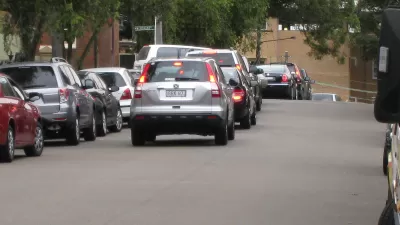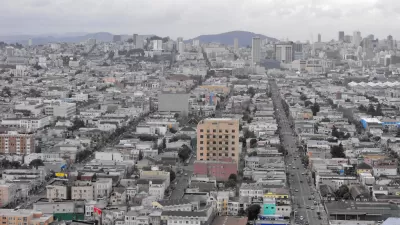Emissions

How Schools Can Address Idling Cars
Schools can do more to reduce the environmental threat posed by idling cars during drop-off or pick-up. School districts could also improve their buses with that aim in mind.
The Health and Social Justice Implications of 'Line-Source' Air Pollution
The most dangerous air pollution is not smog and is barely known by the public, writes Bill Adams, editor of UrbDeZine. Line-source particulate matter air pollution could change the way the public thinks about road projects and gas powered cars.

San Francisco's Running Out of Room for Cars
In terms of land area, San Francisco’s a small city. Yet if current policies persist, the city will build 92,000 parking spots for residents by 2040, on just 49 square miles of land.
Responding to Smart Growth Criticism
Critics claim that smart growth policies are ineffective at reducing vehicle travel and achieving intended to objectives. This column critiques their arguments.
How Does Placemaking Pay?
Hazel Borys compiles an extraordinary list of studies quantifying the role of livable, walkable places in building equity, city coffers, health, and social capital.
An Inaccurate Attack On Smart Growth
Note: This column was originally titled, "A Stupid Attack on Smart Growth," intended as a pun on 'smart' and 'stupid.' However, that sounds harsh so I retitled it. - T.L. The National Association of Home Builders (NAHB) has a well-financed campaign to discourage communities from considering smart growth as a possible way to conserve energy and reduce pollution emissions. They contend that compact development has little effect on travel activity and so provides minimal benefits. The NAHB states that, “The existing body of research demonstrates no clear link between residential land use and GHG emissions.” But their research actually found the opposite: it indicates that smart growth policies can have significant impacts on travel activity and emissions.
Evidence That Smart Growth Strategies Curb Emissions
A new report from the Victoria Transport Policy Institute says that new evidence shows that smart growth policies can have a significant effect on vehicle miles traveled and thus reduce emissions.
First Nation-Wide Count of Parking Spaces
A new study estimates there are at least 500 million off-street parking spaces in the U.S. This represents 0.5% to 12% of estimated lifecycle energy consumption and greenhouse emissions, and 24% to 81% other air pollutants.
Stopping Sprawl, Slowing Emissions, Improving the Economy
A new report suggests that making policies in Canada to avoid urban sprawl development will reduce pollution and boost the economy.
Stockholm's Congestion Pricing Cuts Traffic, Boosts Clean Vehicle Sales
Stockholm's congestion charge is not only reducing traffic and greenhouse gas emissions, it's also increasing sales of alternative fuel vehicles.
EPA OKs California's Plan to Regulate Emissions
The Environmental Protection Agency has reversed a decision by the Bush Administration that will allow California to create its own set of vehicle emissions standards.
Climate Change is Local, Says Chu
U.S. Energy Secretary Stephen Chu said at the Asia Society Washington, D.C. center awards dinner that "climate change is the greatest challenge facing science."
Sustainable Sites Initiative: A New Stand-alone Rating System
The National Building Museum recently held a session on Sustainable Sites Initiative, which outlines voluntary guidelines for sustainable practices.
Designers Should Lead to Fight Emissions
WorldChanging argues that more leadership from architects, landscape architects and planners is needed in a review of progress on Ed Mazria's 2030 Challenge, which calls for all buildings to be carbon neutral by 2030.
Obama to Announce Tougher Standards for Autos Tomorrow
The Obama administration has announced that it will issue new emissions and mileage requirements for cars and light trucks tomorrow to create a single national standard.
Just-In-Time For Hybrid-Electric Shipping?
An article posted last week by the Guardian and highlighted yesterday by Treehugger.com cites recent studies as well as data from maritime industry sources that the combination of quantity and quality of low-grade bunker fuel used in the massive engines of freight vessels may result in more emissions than all the cars in the world! I don’t mean to wax sensationalist here, this is what is stated in the article. If the truth is anywhere near the statement, then the idea of
Schwarzenegger Vetoes Port-Air Pollution Bill
CA Governor Schwarzenegger vetoed perhaps the most important air quality bill of the year just before the deadline to the dismay of the state's environmental and health community. Alaska Gov. Palin's letter asking for the veto may have played a role.
Please Tax My Carbon
North American (United States and Canada) policy generally favors low energy prices, with low taxes, production subsidies and other types of energy industry support. As a result, North Americans are energy rich: an average worker can purchase more fuel per hour of labor than almost any other time or place. In response North Americans have developed energy intensive lifestyles and industrial practices, have failed to implement many energy conservation practices common in other parts of the world, and consume more energy per capita than most other times and places.
Smart Growthers Snooze, EJ Advocates Roar, Carbon Solutions Wither
The coal industry, electric utilities and manufacturers are in line to get trillions of dollars in federal funding to reduce carbon emissions, leaving virtually no money for smart growth and transit solutions to climate change.
Smart Transport Emission Reductions
Last week I attended the NREL Energy Analysis Forum, where leading North American energy analysts discussed current thinking concerning greenhouse gas emission reduction strategies, much of which involves emission cap and trade programs (as summarized in the report by Resources for the Future, "Key Congressional Climate Change Legislation Compared"). Similarly, a recent report, "Reducing U.S. Greenhouse Gas Emissions: How Much At What Cost" evaluates emission reduction strategies according to their cost effectiveness.
Pagination
City of Costa Mesa
Licking County
Barrett Planning Group LLC
HUD's Office of Policy Development and Research
Mpact Transit + Community
HUD's Office of Policy Development and Research
Tufts University, Department of Urban and Environmental Policy & Planning
City of Universal City TX
ULI Northwest Arkansas
Urban Design for Planners 1: Software Tools
This six-course series explores essential urban design concepts using open source software and equips planners with the tools they need to participate fully in the urban design process.
Planning for Universal Design
Learn the tools for implementing Universal Design in planning regulations.
































